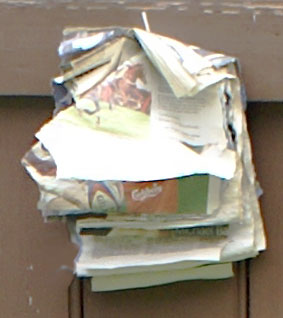Waste previously barely or not existed. Everything was still (re) usable for something.
 Paper was used again: the blank back of printing to write, papers as insulation (in boots, shoes, after winter cloths and to stop gaps), as kindling and fuel, to rub washed windows dry, as packaging (for vegetables, eggs...) and as a toilet paper. So probably your ass sometimes looked printed. And the remaining paper (cardboard) was bound and retrieved by the youth association to fill the cash.
Paper was used again: the blank back of printing to write, papers as insulation (in boots, shoes, after winter cloths and to stop gaps), as kindling and fuel, to rub washed windows dry, as packaging (for vegetables, eggs...) and as a toilet paper. So probably your ass sometimes looked printed. And the remaining paper (cardboard) was bound and retrieved by the youth association to fill the cash.
Other packages were when empty handed back again: jute sacks of grain, flour, potatoes, bottles for milk (if you did not have milk jug or jar), beer, wine, vinegar. And we collected empty bottles to make wine our self. Glass jar with lid I still use to make jam and applesauce.
Old garments traveled as long as they were useful, the whole family around. Then pieces were cut up and remade into children's clothing, lining, pockets, bags for sandwiches or gym shoes, oven mitts, towels, handkerchiefs, replace worn collars and cuffs, elbow attachments, cleaning cloths (kitchen tissue did not exist), dish rag, pillow- or dolls filling. Knitwear was pulled out so that the yarn could be used again. And some went to the dress suitcase to play with. The last one who relished was the ragman.
Anything remotely edible went to the animals (rabbit, dog, pig, chicken...), even the crumbs from the table. And what could perish ended up on the dunghill. A compost heap also did not exist. Bones went to the dog or pig, egg shells back to the chickens.
Building material stayed good. Mud walls, whether or not limed, chunks were put a winter outside and were again loam and kindling. Beams were reused, sills and windows too. Pieces of wood became fuel.
With lime mortar masonry brick were cleaned, the debris strewn and stones reused.
Even bent nails were recovered and knocked straight again. Tools were reforged. Scrap metal was sold every few years to an ironmonger.
Tinfoil went to the nuns for 'missions'. No idea what they did with it.
The few cans we had were used to store nails and screws, to ladle chicken feed, to make (see Pig slaughter) tin graters and as toys.
Just about everything had value and was saved. It would ever be able to serve for something.
Plastics, synthetic stuff and electronics were barely. And so, before there was waste collection such waste was sometimes burned in the garden.
Only some fragments remained. And even then. Glass shards had purchased to scrape off old paint from woodwork. Shards and pieces of tile or tiles were used for roads, as bedding, under the floor, or to fill holes in the earthen road.
Things had earlier last a lifetime. Now we make waste, that when you buy it, for a short time can be used for something. On this website you can only buy products that will last a lifetime. www.buymeonce.com
In 2003, our country ended around 45,000 tonnes of used electrical devices on the scrap heap. In 2012 it was more than 110,000 tonnes. More than double so, and one of the biggest reasons for this, we must obviously look for the perfect sophisticated tactics of the manufacturers. “Devices could work, as the producer would want so, a lot longer, "says the German parliament Doro Steiner. "But then you obviously do not buy a new one soon. So they shorten the life deliberately."
And there are several tricks for. “In devices that make turning movements, such as mixers or toothbrushes, they make the gears in plastic. It costs less and wears more quickly. In TVs are in the electrical supply cheap capacitors, resulting in longer life is shortened by as much as ten years. Or wear parts are near a heat source. And washing machines have too light cables, so the unit also has to give up faster."
(From The Newspages, March 2013)
